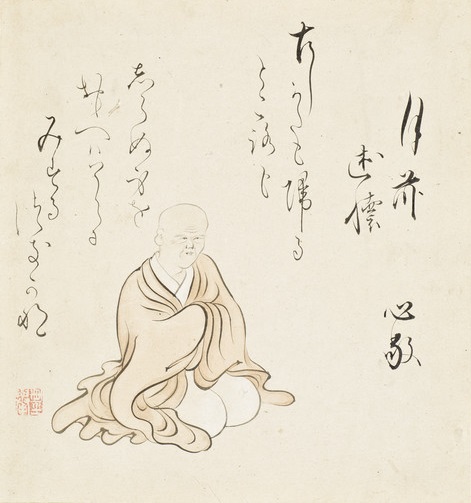ZEN MESTEREK ZEN MASTERS « Zen főoldal « vissza a Terebess Online nyitólapjára
心敬 Shinkei (1406-1475)

Portrait from the album Selection of Thirty-six Poets Beyond the Anthologies
by 酒井抱一 Sakai Hōitsu (1761-1829)
ink and color on paper, 21.59 x 20.32 cm
LACMA (Los Angeles County Museum of Art)
https://fr.wikipedia.org/wiki/Shinkei
Shinkei (心敬?), (1406 à Taishō, province de Kii (de nos jours Wakayama, préfecture de Wakayama) - 14 mai 1475) est un prêtre bouddhiste japonais ainsi qu'un poète tanka (poésie) et renga.
Shinkei est prêtre bouddhiste à un âge précoce et s'élève rapidement au rang de daisōzu. Il considère la poésie comme le résultat d'un mode de vie religieux (shugyō). Pendant plus de trente ans il reste élève auprès du poète 清巌正徹 Seigan Shōtetsu (1381-1459). Ses poèmes se basent sur l'idéal esthétique japonais appelé yūgen.
Outre des poèmes, il rédige aussi des textes poétiques, Sasamegoto (ささめごと) 1463 et Oi no kurigoto (老のくりごと) 1471.
PDF: Heart's flower: the life and poetry of Shinkei
by Esperanza Ramirez-Christensen
Stanford University Press, 1994Esperanza Ramirez-Christensen is Professor of Japanese Literature at the University of Michigan. She is the author of Heart's Flower: The Life and Poetry of Shinkei (Stanford, 1994), and the co-editor of The Father-Daughter Plot: Japanese Literary Women and the Law of the Father (2001).
Foothills beneath
a deepening pall ofsnow
as twilight falls.Far away in a cedar grove
the muffled boom of a bell.*
Such a mind is, indeed,
that of a Buddha!
The infant-child
is still free from drawing
distinctions.*
As darkness falls,
swollen with stormy winds
it spits the moon:
the looming peak of autumn
pines chill along the crest.*
Without understanding,
would it not become a hindrance
to the Dharma?In the boat, observing the wind
in the drifting clouds at sea.*
Cuckoo
[A one-hundred verse sequence, of which the last ten verses are given here]
1 In the swift current,
was that boat cast adrift upon
the evening river?2 The incessant sound of
waves pounding the shore.3 Yellow mountain roses—
with each petal shower the water
turns, colorless.4 The eightfold dewdrops also
a hazy shimmer in sunlight.5 The spring rain is
seeping finely over all,
this morning.6 A heart is breaking into shards
in wake of the dawn’s parting.7 Surely there are
worlds where one can live free
of this yearning.8 But how can I ever find
the way to quiet my mind?9 On moonlit nights, and
even nights blotted of the moon,
I lie disconsolate.10 About the rice-warden’s pallet,
the chill of the wind deepens.*
Invisible as the wind to the eye,
the mountain echo from the sky.In everything
is and is-not are wholly
a matter of form.*
Soul mad with longing
wanders oft'into the sky.A crow shrieks—
before the moon of a frosty night
I lie alone.*
“If it be so,
so be it!” Having said thus,
why the hurry?For the shadow trails the light,
implacably, indifferent to men.*
A temporary lodging
on this side of the road all
must go, in the end.To recover the time he rested,
the traveller hastens on.
[私語 Sasamegoto (1463–1464) by 心敬 Shinkei (1406-1475)]
Murmured Conversations: A Treatise on Poetry and Buddhism
by the Poet-Monk Shinkei
Translation, commentary and annotation by Esperanza Ramirez-Christensen
Stanford University Press, 2008, 432 pages
https://www.questia.com/library/118649479/murmured-conversations-a-treatise-on-poetry-andMurmured Conversations is the first complete and rigorously annotated translation of Sasamegoto (私語 1463–1464), considered the most important and representative poetic treatise of the medieval period in Japan because of its thoroughgoing construction of poetry as a way to attain, and signify through language, the mental liberation (satori) that is the goal of Buddhist practice. It is a fascinating document revealing the central place of Buddhist philosophy in medieval Japanese artistic practices. Shinkei (心敬 1406–1475), the author of the treatise, is himself a major poet, regarded as the most brilliant among the practitioners of linked poetry (renga) in the Muromachi Period.
Along with the extensive annotations, Ramirez-Christensen's commentaries illuminate the significance of each section of the treatise within the context of waka and renga poetics, of the history of classical Japanese aesthetic principles in general and of Shinkei's thought in particular, and the role of Buddhism in the contemporary understanding of cultural practices like poetry. This is the most comprehensive presentation available in English of a major classical Japanese critical text.